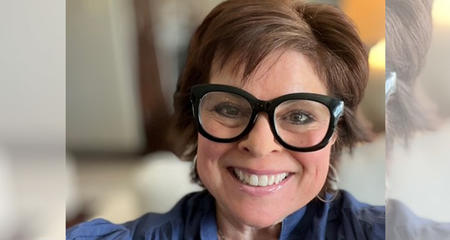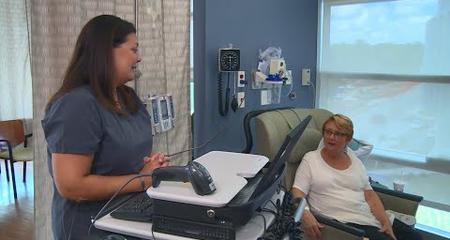Tumors at the base of your skull require special treatment and observation. These tumors sit near the brain stem, the cerebellum and pituitary gland — areas of the brain vital to your quality of life.
The brain stem is responsible for your body's most basic functions, including your heartbeat, breathing, digestive tract and more.
The cerebellum coordinates movement and balance, as well as your ability to move precisely and with accuracy. It helps with posture and may contribute to your attention span and speech.
A skull base tumor is serious, but it is something you can live with and it is treatable. We have experts from several areas forming a team that looks at your tumor from a variety angles to give you the most personalized plan offering the best outcomes. Our team includes experts from the following programs.
- Neurology and neurosurgery
- Otolaryngology (ear, nose and throat, ENT)
- Endocrinology
- Neuro-oncology (brain and spine cancers)
- Radiation oncology
Conditions Treated Within the Skull Base Tumor Program
- Acoustic neuroma (vestibular schwannoma)
- Adenoma (pituitary tumors)
- Angiofibroma
- Arachnoid cysts
- Basilar invagination
- Cerebrospinal fluid (CSF) leak
- Chondroma
- Chondrosarcoma
- Chordoma
- Colloid cysts
- Craniopharyngioma
- Dermoid cysts
- Encephaloceles
- Epidermoid cysts
- Fibrous dysplasiaGiant cell tumor
- Hemangiopericytoma
- Meningioma
- Metastatic brain tumors
- Nasopharyngeal angiofibroma
- Neurofibroma
- Olfactory neuroblastoma (esthesioneuroblastoma)
- Optic nerve compression
- Osteoma
- Paranasal sinus cancer
- Petrous apex lesions
- Pinealblastomas
- Pineal gland tumors
- Rathke's cleft cyst
- Rhabdomyosarcoma
- Schwannomas
- Sinus tumors
Skull Base Tumor Symptoms
Symptoms include headaches and vision changes, along with balance issues and problems with motor skills. Many of these symptoms apply to other conditions as well, so it is important to see experts in diagnosing and treating brain tumors.
Diagnosing a Skull Base Tumor
An accurate diagnosis is vital when it comes to creating a treatment plan. As an academic medical center, we have access to state-of-the-art diagnostic tools and procedures, including.
- Biopsy provides our pathologists with a sample of the tumor to determine if it is benign or cancer.
- CT scan pinpoints the tumor location and structures around it.
- CT angiogram looks specifically at the blood vessels in the brain.
- Dotatate scan uses a special radioactive tracer to help detect and diagnose the tumor.
- Lumbar puncture checks the spinal fluid for abnormalities.
- Magnetic resonance angiography (MRA) examines blood vessels around the tumor, including any that feed into the tumor.
Monitoring the Tumor
If the tumor is benign (noncancerous) and not growing, we may put you on a schedule to come in every few months or once a year for a CT scan and other tests to check the size and status of the tumor. This is definitely an option if the tumor is not causing any symptoms and is not affecting any brain functions. If you are in a monitoring program and experience any vision changes, balance issues or motor skill coordination issues, contact your care team immediately.
Radiation for Skull Base Tumors
Your team will include a radiation oncologist who can weigh the benefits of treating your tumor with radiation. Radiation treatment has advanced to a level where we can target the tumor without damaging the surrounding tissues.
Skull Base Tumor Surgery
Traditional skull base tumor surgery involves opening the skull, moving muscles and working around other structures in the brain until we find and remove the tumor. In some cases, this is still necessary.
In most cases, however, we can use minimally invasive techniques to remove your skull base tumor. Keyhole surgery relies only on a small hole drilled in the skull.

Endoscopic Endonasal Approach
Our most exciting option is a nasal approach using a small camera to approach the tumor and requires a team approach. An ENT specialist evaluates the optimal path to the tumor, opens the nasal cavity and exposes the tumor. Nathan Zwagerman, MD, Froedtert & MCW neurosurgeon, is one of a handful of neurosurgeons in the U.S. trained in this endoscopic approach.
This minimally invasive technique has several advantages — including a shorter hospital stay, shorter recovery time, no large external incision. Not all patients are eligible for this technique. It is dependent on the tumor placement. A transorbital approach may be recommended. For instance, if the tumor is behind the optic nerve, this approach could affect your vision. Your surgeon will discuss your options and goals to determine what is best for you.
What to Expect for All Skull Base Tumor Surgery
Prior to the surgery, you will meet with the neurosurgery and ENT teams, as well as an endocrinologist if one of the endocrine structures is involved. You will have labs to check hormone levels and imaging to verify the tumor positioning.
For the surgery, you will have special stockings on your legs to prevent blood clots. You may need a catheter to monitor urine output.
After surgery, you will have techniques to avoid sneezing. If you cannot avoid it, keep your mouth open. We plan have you up and walking that day. You will also receive pain control and a stool softener as needed. You may need steroid therapy and medicine to protect the stomach from the steroids.
Potential Risks After Brain Surgery
While minimally invasive, there are risks:
- Cerebrospinal Fluid (CSF) leak
- Nosebleeds
- Cranial nerve palsy
- Infection
See the list below for symptoms you should look out for that could indicate one of these complications.
After Discharge from the Hospital
One to two weeks after discharge, you'll have follow-up appointments with your care team and a blood draw. At four to six weeks, there will be another set of follow-up appointments. At the four-month follow-ups, you will have your first post-surgical MRI to check the area where the tumor was.
We encourage you to walk, but you should avoid strenuous activity. Do not lift anything more than two pounds (including pushing or pulling). Avoid bending over and any excessive straining. These activities increase the risk of bleeding or may cause cerebrospinal fluid to leak from the nose. You can resume your diet and shower or bathe as soon as you want to. You should not drive if you are taking narcotics. Your surgeon will clear you to return to work — usually around two weeks after surgery.
Use saline spray for nasal dryness. Avoid sneezing and sneeze with your mouth open if you can't stop it. We will show you how to do nasal irrigation. You will need to do these two or three times a day. Irrigate both nostrils over the sink, toilet or shower. Your care team will go over any medication restrictions — including aspirin, acetaminophen and ibuprofen.
Contact your care team if you have any of the following symptoms.
- Confusion or change in mental condition
- Persistent chills or fever (101º or more)
- Severe headache or increase in nasal pain
- Vision changes
- Watery nasal discharge or salty taste (beyond the saline spray or nasal irrigation)
- Nausea, voting or diarrhea
- Extreme urination (especially during the night)
- Extreme thirst
- Lightheadedness or faint feeling
- Persistent nosebleeds
- Cold or sinus infection that doesn't improve after seven days
- Puffiness or swelling
- Extreme tiredness
Virtual Visits Are Available
Safe and convenient virtual visits by video let you get the care you need via a mobile device, tablet or computer wherever you are. We’ll gather your medical records for you and get our experts’ input so we can offer treatment options without an in-person visit. To schedule a virtual visit, call 1-866-680-0505.
More to Explore





